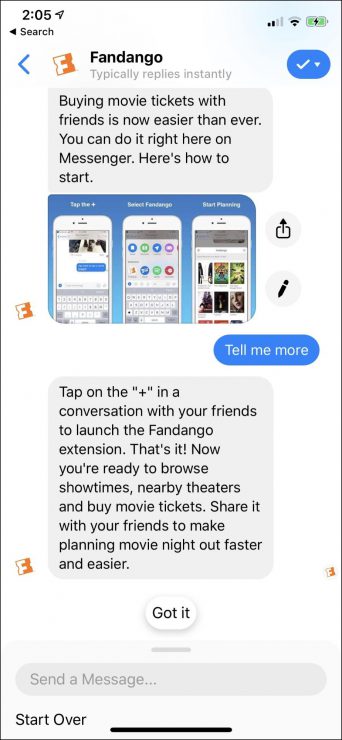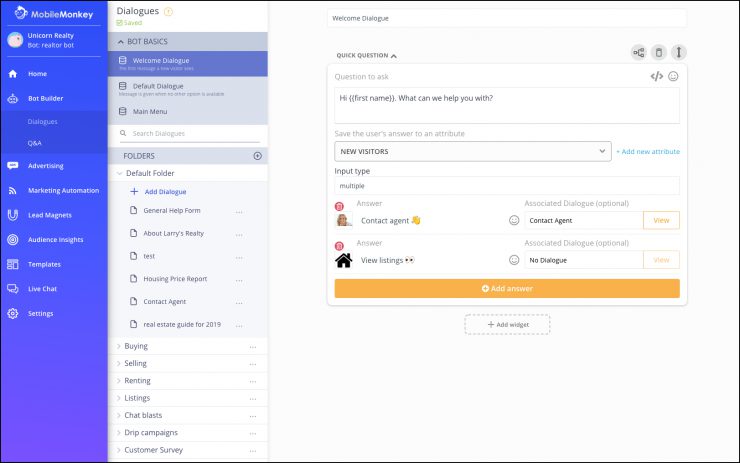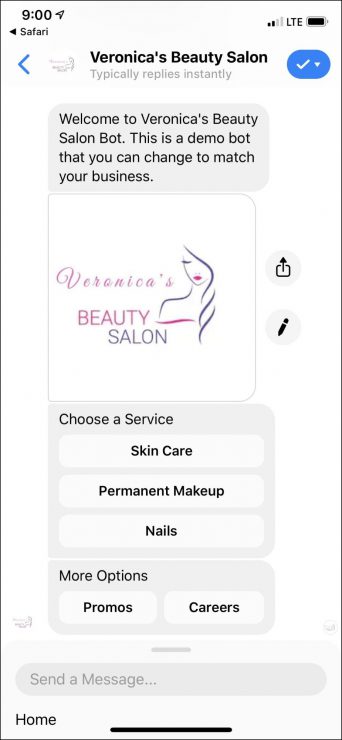After reading this guide, you will have a clear understanding of how a chatbot works and real-world results that chatbots can deliver.
And, most importantly, you’ll have a clear action plan for using chatbots to help your business succeed in sales, marketing, and customer service.
What Is a Chatbot?
A chatbot is a computer program that can simulate conversation and interact with humans.
That’s a pretty simplistic definition. Chatbots are enormously powerful, scalable, and can do so much more than just “talk.”
You’ve used a chatbot before. I almost guarantee it.
Look in the lower right corner of your browser. There’s a chatbot.

Hop in there and you can be interacting with our chatbot in just a few seconds. (You should try it out.)
Here is Fandango’s chatbot and I having a little convo.

Want some news? Hop over to CNN’s chatbot for that.

Chatbots, of course, work on other platforms than just Facebook Messenger.
You might order coffee using the Starbucks chatbot in an app.

Or Slack. Slack has all kinds of chatbots.

There’s this classic chatbot if you’re an Apple device user.
Chatbots are kind of everywhere.
And, if Google Trends is any indication, the past couple of years have seen a massive increase in general interest in chatbots.
Why the popularity in chatbots?
Apart from the obvious — it is an emerging and expanding technology — chatbots are both incredibly useful and easy to create.
And that’s exactly why cutting-edge marketers and forward-thinking professionals are creating sales chatbots, marketing chatbots, and customer service chatbots.
How Do Chatbots Work? The Different Types of Chatbots
How do chatbots work?
From a high-level view, it looks like this:
- A user — you, a person, your aunt — communicates with a computer program. Maybe you type. Maybe you talk. Maybe you smile and wave.
- The computer program responds to what you’ve said based on how it has been programmed. Perhaps you typed “price,” and the chatbot has been programmed to serve up information about product costs.
The idea is simple.

Chatbots can take different forms, depending on how they’re used.
For example, some chatbots use AI (artificial intelligence) and NLP (natural language processing) to simulate human conversation.
AI technology allows these chatbots to better understand, adapt to, and respond to a conversation.

Chatbots with advanced technology like NLP are certainly useful, but for the day-to-day use of sales, marketing, and customer service, basic chatbots are perfect.
Chatbots also differ according to where and how you interact with it.
For example, you can build chatbots to work on Skype, Slack, Kik, WhatsApp, Facebook Messenger and just about anywhere else that messaging is permitted.
Facebook Messenger is one of the most popular chatbot platforms because of its sheer size — 1.3 billion users as of mid-2019.

Creating a chatbot on Messenger is very simple.
All you need is a Facebook Messenger chatbot builder.
What is a Facebook Messenger chatbot builder?
A chatbot builder for Facebook Messenger is an app that allows you to build chatbots that work in Facebook Messenger. Anyone can make them because most chatbot builders are straightforward and easy to use.
For example, creating a chatbot in Customers.ai, one of the premier Messenger chatbot builders, is a simple drag-and-drop job.

Take a look at that screenshot above one more time.
You don’t see any of this, do you?

To make a Facebook Messenger chatbot, you don’t need to know any code.
That simplicity is one of the big reasons why chatbots are soaring in popularity among salespeople, marketers, and customer service professionals.
How Do Chatbots Work in Sales, Marketing, and Customer Service?
Imagine the following scenario.
You’re in business selling a product or service.
And one of your biggest pain points is customer service.
- Where’s my order?
- How much does this cost?
- Do you have that shirt in robin’s egg blue?
- When will my shipment arrive?
- What are your hours?
- Can you send me directions to your store?
The customer service requests are never-ending. So you consider expanding to something like this.

Which is expensive, by the way. And complex. And goodbye profit margins.
What if you could replace all of that, with a customer support chatbot?

The bot handles inquiries, schedules appointments, gives store hours, sends directions, provides coupons, and handles all those details of customer service.
(You, by the way, may choose to sleep while all of this goes down.)
When you use a chatbot for customer service, everyone wins — the customers, the customer service team, you, your aunt, everyone.

Let’s spin another use chatbot use case.
How do chatbots work in marketing?
This is huge.
Facebook Messenger Marketing is the panacea to the death of email marketing, the bane of cold-calling, and the misery of expensive Facebook advertising.
As Larry Kim and I have been asserting, “Facebook Messenger marketing is the hottest opportunity in digital marketing today.”
Facebook Messenger marketing uses Messenger to reach and connect with potential customers. Your Messenger chatbot performs the tasks and responsibilities of a high-octane marketing team. (Without the high-octane costs.)
For example:
- Your Messenger chatbot sends a drip campaign to 19,019 users automatically.
- As the users respond, your chatbot is seamlessly hypersegmenting them into specific groups based on demographics, psychographics, specific responses, and even how much they spend on makeup each month. (Seriously. There’s no limits on what you can do.)
- The chatbot automatically pings these customers 24 hours after their interaction to remind them, invite them for a chat, or simply to provide another offer.
- Your chatbot even facilitates a webinar — getting signups, checking schedules, and providing access codes.
This is only the toenail of the colossus that is Facebook Messenger marketing.
Here’s an example of how it might look in real life.
Say you want to run a contest to attract new leads and engage existing leads. No problem. Your chatbot is up to the task.

Messenger chatbots are also enormously beneficial for Facebook advertising. Using Messenger ads you can lower advertising costs, increase conversions, and gain more leads.
To run Messenger ads, you have to build a Messenger chatbot.
What kind of tools do you need for all of this sales and marketing chatbot wizardry? It’s simple — a subscription to Customers.ai and grade-school technical chops. You’re set.
In summary, chatbots work for business by handling massive workloads in three major areas:
- Marketing — acquiring new leads, engaging with existing customers, etc.
- Sales — enabling transactions
- Customer Service — providing customer care, answers to questions, and other routine customer requests and needs
Why Chatbots Are So Important Right Now
Chatbots are crucial now for their bottom-line benefits.
- Chatbots provide individual connections to a limitless number of users at scale.
- Chatbots automate routine tasks.
- Chatbots facilitate superior customer care.
- Chatbots allow for a personalized experience.
- Chatbots are interactive, allowing for a back-and-forth conversation with feedback
- Chatbots are efficient.
- Chatbots save money.
Chatbots are basically unicorns — everything good about the Internet in one place.

There’s an underlying corollary to these benefits. Using chatbots is an imperative right now because of a timing issue.
Chatbots are easy to make and extremely powerful. But very few businesses are using chatbots!
If you choose to make chatbots now, you are effectively gaining first-mover’s advantage.
How to Build Chatbots. It’s easier than you think.
The next logical questions is this — how do I make one?
We’ve got you covered. The process is quick and simple and laid out in exacting detail right here.
In summary, it looks like this:
- Sign up for Customers.ai and open the app.
- Connect your Facebook Business Page with the Customers.ai chatbot builder.
- Click on Bot Builder and it’s go-time.

If creating a chatbot from scratch is intimidating, don’t sweat it.
Customers.ai comes with a whole library of chatbot templates. Whatever your chatbot use case, you will find a customizable chatbot template that fills the need.

Select the industry you’re in or the chatbot functionality you want, and customize what’s already there.
How to Make Chatbots Work for You
Let’s wrap this up with a few hot tips on how chatbots can rocket your business to greater heights:
First, evaluate which of the three areas chatbots will have the biggest impact for your business.
Is it sales? Marketing? Customer service?
Pick an area that is taking up a lot of your time and effort. Your chatbot will instantly alleviate the pressure.
Second, come up with the specific angle your chatbot will address.
If the biggest impact is sales enablement, for example, create a bot that qualifies leads/guides shoppers through to find their perfect product/solution.
If the biggest impact is lead generation, create campaigns to acquire users at the top of the funnel or remarket to prospective contacts.
Third, create your chatbot using Customers.ai’s chatbot builder. Use a template to save time.
Fourth, segment your contacts, saving attributes or tags for questions you ask. These allow for personalization in follow up, and will serve as an outstanding asset for your future marketing and remarketing needs.
Finally, integrate chatbots with your other business systems. Customers.ai uses Zapier integration, meaning that your chatbot can plug into all your other business systems and apps.
Next Steps for Chatbot Success
- If you haven’t done it yet, sign up for Customers.ai. Everything starts there.
- Receive the occasional chatbot power tip by getting plugged into our Facebook Messenger channel.
- Join the free Facebook Group, where thousands of Facebook Messenger marketers pool their insights, hacks, and tips.
